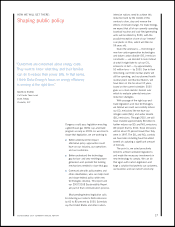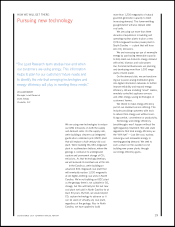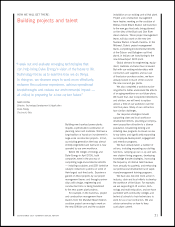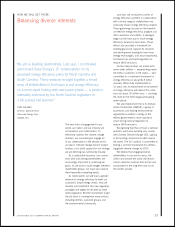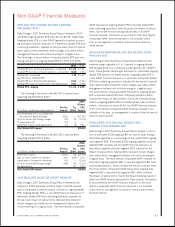Duke Energy 2007 Annual Report Download - page 23
Download and view the complete annual report
Please find page 23 of the 2007 Duke Energy annual report below. You can navigate through the pages in the report by either clicking on the pages listed below, or by using the keyword search tool below to find specific information within the annual report.
DUKE ENERGY 2007 SUMMARY ANNUAL REPORT 21
“I seek out and evaluate emerging technologies that
can help bring Duke Energy’s vision of the future to life.
Technology forces us to examine how we do things.
In doing so, we discover ways to work more effectively,
enhance the customer experience, achieve operational
breakthroughs and reduce our environmental impact —
all critical to preparing for a low-carbon future.”
NEETA PATEL
Director, Technology Development & Application
Duke Energy
Cincinnati, Ohio
Building new baseload power plants
requires sophisticated coordination of
planning, labor and materials. We have a
long tradition of hands-on involvement in
large-scale construction projects. In fact,
our existing generation fleet was almost
entirely engineered and built and is now
operated by our own workforce.
Before the merger of Cinergy and
Duke Energy in April 2006, both
companies were in the process of
completing large environmental retrofits
— installing scrubbers and SCR (selective
catalytic reduction) systems on some of
their largest coal-fired units. Experience
gained on those projects by our project
management teams and through partner-
ships with design, engineering and
construction firms is being transferred
to the new power plant projects.
For example, in the Carolinas, project
and construction management team
leaders from the Marshall Steam Station
scrubber project are moving to work on
the new Cliffside unit and the scrubber
installation on an existing unit of that plant.
Project and construction management
team leaders working on the scrubber at
Belews Creek Steam Station will transition
to the new gas-fired units being planned
on the sites of the Buck and Dan River
steam stations. These project management
teams will also work on the new Lee
Nuclear Station in South Carolina. In the
Midwest, Duke’s project management
teams completing environmental retrofits
at the Gibson and Gallagher coal-fired
plants in Indiana are transitioning to the
new Edwardsport IGCC plant.
Global demand for engineering, equip-
ment, materials and labor has increased.
But with our existing relationships with
contractors and suppliers and our use
of fixed-price purchase orders, we have
already locked in much of the costs for
the new coal and gas plants.
We also completed a workforce plan-
ning effort to better understand the effects
of an aging workforce on our future plans.
We found that, due to expected retirements
and attrition, we will need to replace
almost a third of our workforce over the
next five years. Many of our contractors
face similar challenges.
Our response strategies include
supporting state and local workforce
development efforts, providing an employ-
ment proposition attractive to a diverse
population, broadening existing and
initiating new programs to ensure access
to top talent, and significantly expanding
our employee development, engagement
and retention programs.
We have already taken a number of
actions, including expanding our staffing
functions, ramping up our co-op and sum-
mer student hiring programs, developing
knowledge transfer strategies, increasing
the frequency of internal talent reviews
from annually to quarterly, and enhancing
our professional development and super-
visory/management training programs.
We have also become more active in
industry, state and local efforts to develop
the workforce of the future. For example,
we are supporting K-12 science, tech-
nology and math education, and we have
partnered with community colleges and
technical schools to train technicians to
work for us or our contractors. We also
advise universities on how to keep
curriculum current.
HOW WE WILL GET THERE:
Building projects and talent








